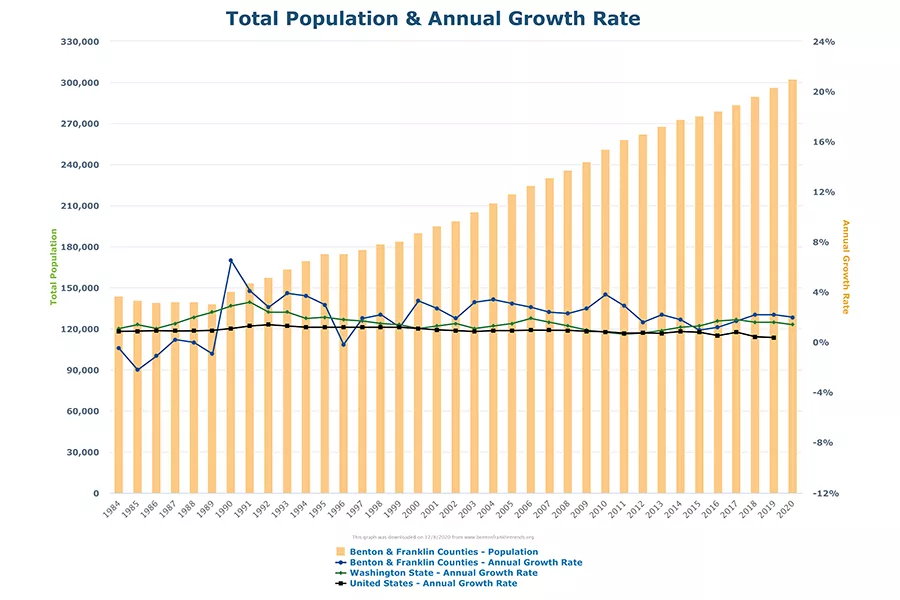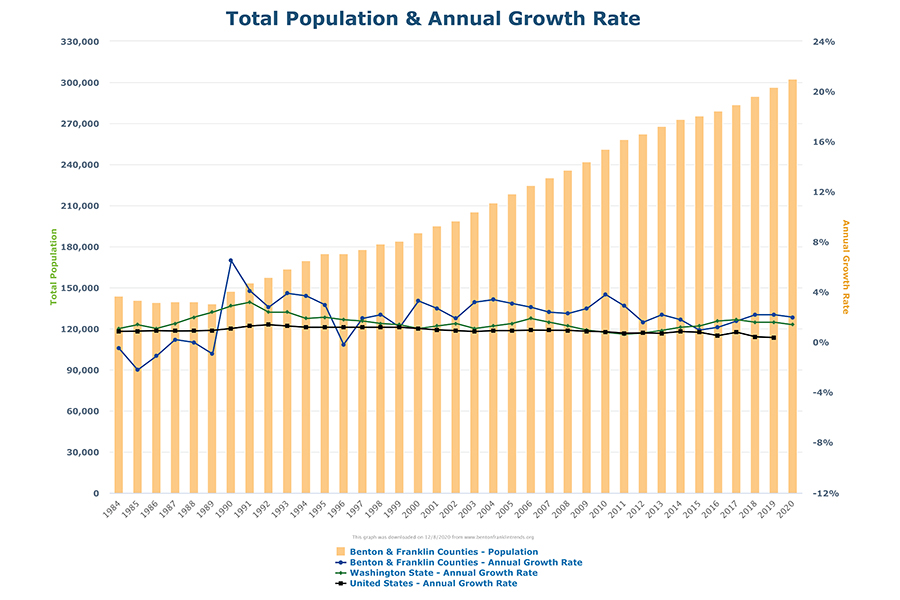
Home » Robust Tri-City population trends expected to continue
Robust Tri-City population trends expected to continue

December 14, 2020
As we close out a tumultuous year where the pandemic has stolen so much of our attention, it might help to step back from the daily challenges and appreciate a fundamental demographic of life here: the greater Tri-Cities continue to grow.
Demographics may not drive destiny, but they certainly influence it.
Unlike many parts of Eastern Washington, the two counties continue to add residents at a brisk pace. The April 1 estimate by demographers at the Office of Financial Management, or OFM, put the population of the two counties over 300,000 for the first time.
This is easily observed in Benton-Franklin Trends graph. The 2020 estimate was nearly 302,500. That represents a gain of about 50,000 residents over the decade beginning in 2010. The lines in the graph represent year-over-year percentage change, and it is clear the growth rate in the two counties has exceed the strong rate of the state for the past three years. On a cumulative basis since 2010, population in the two counties expanded by 20%, easily outpacing the cumulative growth statewide of 14%.
In recent times, the annual growth rate here has been over 2%. If a 2% growth rate were to hold over the next 35 years, the future two counties would count slightly over 600,000 residents.
OFM hasn’t developed a forecast that extends 35 years into the future but has developed one for 20 years from now.
In 2040, demographers at the agency see the population in the two counties at about 410,000. (This is the “mid-range” scenario from the Growth Management Act calculations.)
So our state’s demographers do not think that a 2% growth rate will last but still point to robust increases.
On a cumulative basis, the expected 36% growth represents not only the fastest growth of any metro area in Eastern Washington, but the most rapid increase in any county in the state.
This projected growth raises several questions.
First, which component – in-migration or natural increase – will dominate the increase? The answer to that question will affect a myriad of activities and organizations in the greater Tri-Cities.
For example, if most of the gain comes from natural increase, the school districts will need to keep expansion in mind.
If, however, most of the growth stems from people discovering the two counties and moving here, then school districts will not experience the same attendance pressure.
Either way, municipal government will be impacted – on both the revenue and service delivery sides. Retail sales will definitely climb but their mix will differ, depending on the age profile of the new residents.
Currently, the greater Tri-Cities sport one of the lowest age profiles in the state, as Trends data on median age shows. By 2040, what will be the general age of the new residents? It is this observer’s guess that it won’t be as low as in 2019 at 34.5 years.
Health care providers will definitely want to know by how much the median age, and in particular the share of the 65+ population, will climb. Currently, the share of seniors in the population of the greater Tri-Cities is 14%, the lowest among all Eastern Washington metros.

Second, where will the additional 100,000 residents go within the two counties?
Since 2010, cumulative population growth in Franklin County has outpaced that of Benton County, 26% vs. 18%.
Of the three largest cities, Pasco’s count has been the strongest at 33%. West Richland actually grew as fast as Pasco, but isn’t covered in the Trends data. The implications for local government, real estate and school districts are obvious.
Third, what will the racial and ethnic make-up of the greater Tri-Cities look like with at least 100,000 new residents?
Currently, as Trends data reveals, minorities make up about 40% of the population. In the two counties, this share has risen gently but consistently over the past decade.
The Franklin County share stood at 60% in 2019, by Census estimates. The consequences for people of color claiming an even higher share of the population fall on all aspects of life in the two counties – health, education, business, law enforcement and housing.
Unless you prefer zero population growth, the current and forecasted population growth will be a net plus for the area.
Economic development needs an accessible labor force. Public schools likely prefer to manage growth rather than decline. Local governments should enjoy an expanding tax base.
Will there come a point, however, which marks too much of a good thing? Will some residents begin to think that the communities at the confluence of three rivers are in danger of a paradise lost?
This writer’s hunch is perhaps, but not for a while, maybe a long while.
D. Patrick Jones is the executive director for Eastern Washington University’s Institute for Public Policy & Economic Analysis. Benton-Franklin Trends, the institute’s project, uses local, state and federal data to measure the local economic, educational and civic life of Benton and Franklin counties.
Local News Year in Review
KEYWORDS december 2020





